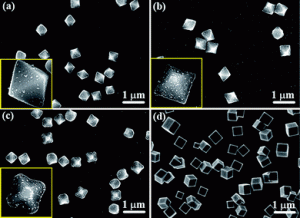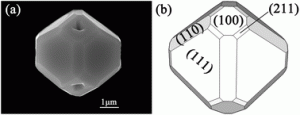 This CrystEngComm Hot article describes the fabrication of SnO2/α-Fe2O3 nanoheterostructures by a hydrothermal process.
This CrystEngComm Hot article describes the fabrication of SnO2/α-Fe2O3 nanoheterostructures by a hydrothermal process.
The structures are made of iron oxide nanoprisms with tin dioxide nanorods on the inner and outer surfaces, which gives them superior visible light photocatalytic properties. The authors believe this is due to ‘the effective electron-hole separation at the SnO2/α-Fe2O3 interfaces’.
Read the full article for FREE to find out more about these nanostructures…
SnO2/α-Fe2O3 nanoheterostructure with novel architecture: structural characteristics and photocatalytic properties
Ju Xu, Feng Huang, Yunlong Yu, Anping Yang and Yuansheng Wang
CrystEngComm, 2011, DOI: 10.1039/C1CE05270E











 Lithium niobate (LN), a nonlinear optical material in its single crystal form, is well proven as a potential and unique material for its use in advanced photonic device applications like second-harmonic generation, optical switching, optical modulators, holographic data storage, acousto-optic and ferroelectric. The transition and rare earth metal ions (Fe, Mn, Cuand Ce) improve the data storage capabilities of LN by improving its photorefraction efficiency. However, when the concentration of dopants in the crystal increase, high geometric strains develop in the lattice resulting in the agglomeration of point defects, the formation of dislocations finally leading to structural boundaries. These defects mask or partially/completely deteriorate some of the anisotropic physical properties of the single crystals and reduce the efficiency of the devices made out of these crystals.
Lithium niobate (LN), a nonlinear optical material in its single crystal form, is well proven as a potential and unique material for its use in advanced photonic device applications like second-harmonic generation, optical switching, optical modulators, holographic data storage, acousto-optic and ferroelectric. The transition and rare earth metal ions (Fe, Mn, Cuand Ce) improve the data storage capabilities of LN by improving its photorefraction efficiency. However, when the concentration of dopants in the crystal increase, high geometric strains develop in the lattice resulting in the agglomeration of point defects, the formation of dislocations finally leading to structural boundaries. These defects mask or partially/completely deteriorate some of the anisotropic physical properties of the single crystals and reduce the efficiency of the devices made out of these crystals. In this HOT article, ZnO nanorods were helped to “stand” vertically on microsubstrates by an interesting seed-mediated approach. Taking ZnO nanosheets as the microsubstrates, ZnO nanorods can grow vertically, not lying horizontally, on the facets with the aid of a seed layer precoating to form hierarchical ZnO nanorod-nanosheet architectures. The diameter as well as the length of the standing nanorods can be controlled effectively by adjusting the growth time and the amount of ammonia in the growth solution. The precoated seed layer has been found to be the key factor in determining the resultant morphology.
In this HOT article, ZnO nanorods were helped to “stand” vertically on microsubstrates by an interesting seed-mediated approach. Taking ZnO nanosheets as the microsubstrates, ZnO nanorods can grow vertically, not lying horizontally, on the facets with the aid of a seed layer precoating to form hierarchical ZnO nanorod-nanosheet architectures. The diameter as well as the length of the standing nanorods can be controlled effectively by adjusting the growth time and the amount of ammonia in the growth solution. The precoated seed layer has been found to be the key factor in determining the resultant morphology.


 In this CrystEngComm Hot article, Michael Lorenz and colleagues from Universitat Leipzig have made fresnoite thin films, fused on various materials by pulsed laser deposition, for use in photonic applications.
In this CrystEngComm Hot article, Michael Lorenz and colleagues from Universitat Leipzig have made fresnoite thin films, fused on various materials by pulsed laser deposition, for use in photonic applications.
 In this HOT article, the Joester group, show for the first time the synthesis and stabilization of amorphous calcium carbonate (ACC) nanoparticles in phosphatidylcholine liposomes (vesicles). There is exactly one nanoparticle per liposome, and the ACC is stable over time (it does not crystallize for at lease 20 h).
In this HOT article, the Joester group, show for the first time the synthesis and stabilization of amorphous calcium carbonate (ACC) nanoparticles in phosphatidylcholine liposomes (vesicles). There is exactly one nanoparticle per liposome, and the ACC is stable over time (it does not crystallize for at lease 20 h). MOF have been much studied due to their potential applications from their excellent physical and chemical properties, however, many are unlikely to realize their potential due to the expense of the starting materials and/or complexity of the synthesis involved. In this HOT article, Day and co-workers have formed stable cucurbit[5]uril MOF structures as ‘beaded’ rings built on a p-hydroxybenzoic acid template prepared readily by self-assembly as a supramolecular structure that remarkably can be recrystallised from water to form the same stoichiometry and structure as occurs under the initial crystallisation conditions. Accessible channels have clearly been demonstrated for a group of polar volatile organic molecules with significant absorption selectivity for at least three examples.
MOF have been much studied due to their potential applications from their excellent physical and chemical properties, however, many are unlikely to realize their potential due to the expense of the starting materials and/or complexity of the synthesis involved. In this HOT article, Day and co-workers have formed stable cucurbit[5]uril MOF structures as ‘beaded’ rings built on a p-hydroxybenzoic acid template prepared readily by self-assembly as a supramolecular structure that remarkably can be recrystallised from water to form the same stoichiometry and structure as occurs under the initial crystallisation conditions. Accessible channels have clearly been demonstrated for a group of polar volatile organic molecules with significant absorption selectivity for at least three examples.